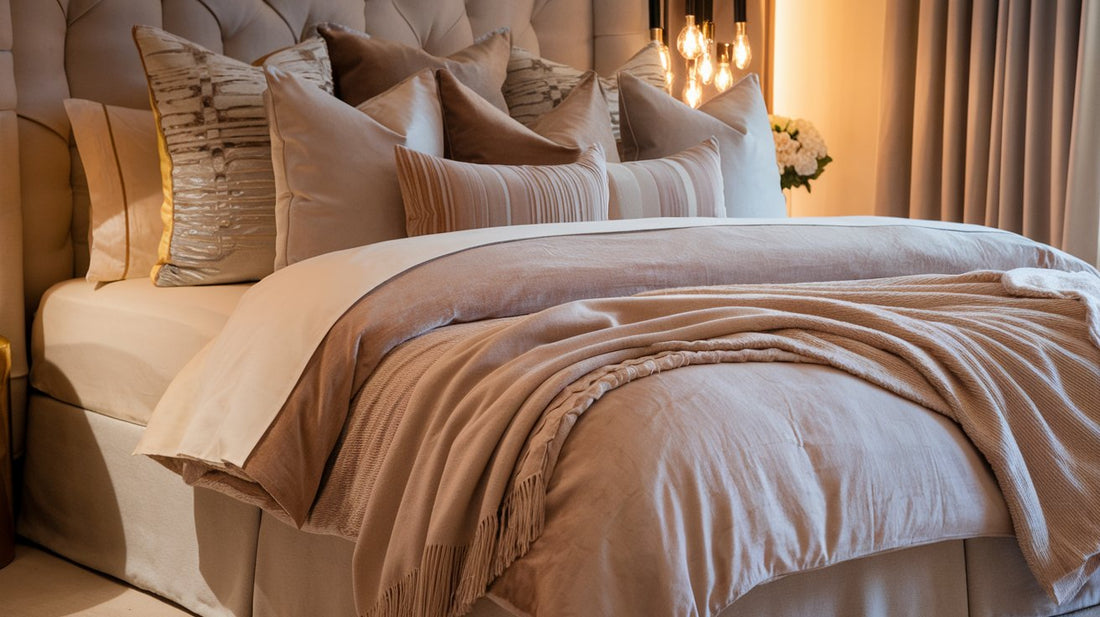The Step-By-Step Guide on How to Layer Bedding

Creating a beautifully layered bed isn't just about aesthetics; it's also about comfort and function. Layering your bedding can turn your bedroom into a cozy, inviting sanctuary. Whether you're aiming for a minimalist style or a luxurious, plush look, knowing how to layer bedding properly can make a huge difference. In this guide, we'll take you through the essential steps for layering bedding like a pro.
Step 1: Start with the Right Mattress and Foundation
Before you even think about the bedding itself, the foundation of your bed is crucial. Start by selecting the right mattress that supports your sleep needs, whether it's firm, medium, or soft. The next key piece is the bed frame and foundation (whether it's a box spring or slatted base). This step ensures that everything sits comfortably and doesn’t sag over time.
If you haven't already, consider investing in a mattress protector. This helps keep your mattress clean, extends its life, and provides an extra layer of comfort.
Step 2: Choose the Perfect Fitted Sheet
The first official layer of your bedding is the fitted sheet. This sheet goes directly over your mattress and fits snugly with elasticated corners to stay in place. The choice of fabric is important for comfort. Cotton, linen, or bamboo are breathable and soft, ideal for most climates.
- Tip: Opt for a sheet with a high thread count for a soft, smooth feel. Thread counts of 300 to 600 are commonly considered ideal.
You can also select a fitted sheet that complements the color palette or theme you want to create in your bedroom. Whether you're going for something neutral or a pop of color, this is your first chance to make a statement.
Step 3: Add a Flat Sheet
Next comes the flat sheet, also known as the top sheet. The flat sheet serves as the barrier between you and your blanket or duvet. Not only does it help keep your bedding cleaner for longer, but it also adds another layer of comfort. For a more polished look, ensure your flat sheet is tucked in neatly, or you can leave the edges loose for a relaxed vibe.
- Tip: In warmer climates, you might prefer to skip the duvet or blanket and use only a flat sheet and a light throw for added breathability.
Step 4: Add a Blanket or Duvet
Now we move on to the heavier layers. Depending on your climate and personal preferences, you'll choose either a blanket, duvet, or comforter.
-
Blanket: A blanket is lighter than a duvet and great for moderate temperatures. Wool, cotton, or a plush throw can add both warmth and texture. Fold it neatly at the foot of the bed, or drape it across the middle of your bed for a layered look.
-
Duvet: A duvet is a thicker, fluffy option, usually filled with down, synthetic fibers, or cotton. The duvet provides excellent insulation and warmth, making it ideal for colder months. For a luxurious touch, consider a duvet cover that complements your bedroom decor. A duvet cover in soft floral patterns or solid neutrals can tie the whole look together.
-
Comforter: A comforter is another excellent option for warmth. It tends to be more affordable than a duvet and easier to maintain, but it lacks the fluffiness of a duvet.
-
Tip: When choosing your blanket or duvet, consider the weight and material. Lighter options like a down alternative duvet are ideal for warmer climates, while heavier duvets are better for colder nights.
Step 5: Layer with Decorative Throws or Quilts
To add depth, texture, and color to your bedding, you can layer a decorative throw, quilt, or coverlet on top of the duvet or comforter. A throw blanket adds dimension and interest to the bed, and you can swap it out seasonally to refresh the look.
A quilt or coverlet can also add an extra layer of warmth during the colder months. It also offers a more structured look compared to a throw, which tends to be more relaxed.
- Tip: Choose a throw in a contrasting color or texture to add an unexpected twist. For example, if your duvet is a solid color, a patterned throw could add visual interest, or if you have a textured duvet, a smooth silk or velvet throw would complement it beautifully.
Step 6: Add Pillows for Comfort and Style
Pillows are essential for both practical and decorative reasons. A variety of pillows adds both comfort and style to your bed. The key to creating a stylish layered look with pillows is mixing different shapes, sizes, and textures.
-
Standard Pillows: These are your basic, functional pillows that you use for sleeping. Arrange them neatly on the bed, either on their own or with pillow shams over them for a more polished look.
-
Decorative Pillows: These smaller, often more colorful pillows can add a pop of color, a fun pattern, or texture. Consider placing two or three decorative pillows at the front of the bed to create a balanced, layered effect. You can use pillows in different fabrics like velvet, linen, or wool to create a mix of textures.
-
Euro Shams: These large, square pillows are great for adding height to your bedding and can make the bed look more luxurious. Arrange them behind your sleeping pillows for a balanced, layered appearance.
-
Tip: Keep a consistent color palette for the pillows, and use an odd number for a more visually pleasing arrangement.
Step 7: Finish with a Bedskirt or Dust Ruffle (Optional)
A bedskirt, or dust ruffle, is an optional yet elegant addition. It covers the area underneath your bed, helping to create a seamless, polished look. It also keeps dust and clutter hidden, which is great for a tidier bedroom.
If your bed frame has exposed legs or the space beneath is visible, a bedskirt is an excellent option. Choose one that complements your bedding color and texture to tie everything together.
Step 8: Add Finishing Touches
The final details are what truly bring the whole bedding ensemble together. Here are some ideas for adding finishing touches:
-
Canopy or Bed Drapery: A canopy bed can look incredibly luxurious when draped with soft, sheer fabrics. If you don’t have a canopy bed, you can still hang drapes above your bed for a similar effect.
-
Bedding Accessories: Decorative items such as a bed tray, scented candles, or small plants can add a personal touch to your bedding. These elements are simple but can enhance the overall look and feel of the room.
-
Color Coordination: Be sure to coordinate the color scheme across all layers. If you have a floral duvet cover, for example, you might want to keep your pillows neutral or use soft shades that match the flowers.
Conclusion
Layering bedding is both an art and a science. By following these steps, you can create a bed that's not only comfortable but also stylish and inviting. Whether you prefer a minimalist, clean look or a cozy, indulgent bed that’s perfect for sinking into, the key is balancing texture, color, and warmth.
Remember, bedding layers should work together to create a space that feels like your personal retreat. Take your time to experiment with different combinations until you find the look that suits your style and comfort preferences.
By layering thoughtfully, you'll not only have a visually appealing bed but a space that promotes rest and relaxation every night. Happy decorating!

